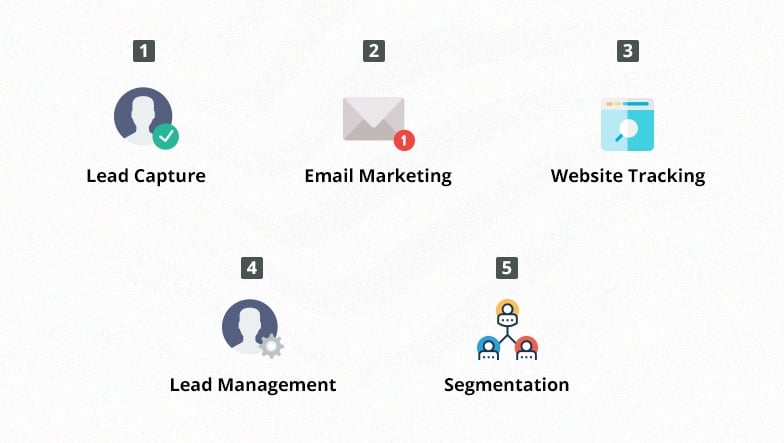Website automation isn’t just the future of online business—it’s available now, and companies would be wise to start taking advantage of it.

Your website is one of your core touchpoints for prospects to enter your funnel. But inefficient tracking, poor lead collection, and manual tasks associated with outreach make it harder to extract the full benefits. As a result, your salespeople spend valuable time picking apart opportunities getting buried in complex processes that could otherwise be used for selling.
Website automation isn’t a magical cure-all, but it can help remove many of the manual tasks that bog down your website’s efficiency and effectiveness.
The future of automation is here – start putting these five powerful features to work and watch your sales revenue grow:

#1 – Lead Capture
Think about how you’re using your website to capture lead information and drop it into your sales funnel. Do you have more than one way to connect with your prospects (e.g. various contact forms, opt-ins, etc.)? If so, what happens to each of those leads after they submit their information?
Companies who aren’t using website automation for lead capture likely have someone to review leads and manually send them to a sales rep.
Automated lead capture takes the manual element out of the process. All data is collected and stored in the right place in a consistent format. There’s less room for error and gives sales reps more time to focus on selling instead of admin tasks.
#2 – Email Marketing
When most marketers think of automation, email marketing is usually the first to spring to mind. Email automation has been around for years, yet more than half of companies still don’t use it.
It’s not because automated email marketing isn’t effective, because countless studies certainly prove it’s worthwhile. Automated emails receive over 85% more opens, almost 200% more click-throughs, and about 320% more sales revenue.
Rather, nearly a quarter of companies find automation to be too complicated to deploy the way they want.
Still, the benefits remain too great to ignore. Integrating your email marketing into your website automation can create seamless lead nurturing that takes much of complexity out of the process. A large part of the complexity stems from having fragmented systems that don’t communicate with each other.
But when you’re able to harmonize your email marketing with your other sales and marketing systems, you get complete insights into the customer profile so you can better use your data to improve your gains.
#3 – Website Tracking
Your website analytics can provide direct insight into general activity but is limited in creating a granular depiction of every customer experience.
Without specialized web tools, there’s no way to determine the path each user took on your website, what they clicked on, when and why they bounced, and where they went next.
Website tracking follows individual paths of each user so you can gain deeper insight into their activities. You can use this data to personalize their experience, know how far they are in the buying cycle, and even help to align sales and marketing teams.
#4 – Lead Management
Are your leads being effectively handled?
It’s hard to know much about a lead if you’re not using automated lead management tools. Automated solutions not only help you capture leads, but can also qualify, score, and distribute leads based on specific criteria. This data shows your sales team where their best prospects lie so they can prioritize their time and resources on deals that are most likely to close.
Here’s what that process can look like:
- Prospects fill out your lead form with their information.
- Website automation tools review the information and determine the quality of the lead.
- Automation also scores the lead based on a number of factors: the more “ready to buy” the lead appears, the higher they score.
- Leads are automatically sent to a specific salesperson based on preset parameters.
- Salespeople receive lead data so they can pursue hot leads before they cool.
Automation gives you direct insight into your leads so that sales teams are better equipped to provide the right solutions at the right time.
#5 – Segmentation
Not all leads are alike, but companies too often take every prospect on the same buyer journey. This not only does your customers a disservice, but it also prevents you from building strong relationships that will improve your sales revenue.
Segmentation breaks this cookie cutter cycle by grouping leads based on certain criteria. You can use segments to tailor your conversations and nurturing to individual customers rather than using a standardized approach.
Sales reps still follow a systematic process, but the end results are more individualized. Sales teams gain a deeper understanding of the buyers’ needs and can deliver a better end solution that benefits both sides.
Try LeadSquared’s Website Automation Platform for Free!
Ready to put the best features of website automation into motion? Try LeadSquared free for 15 days and see how we can help you grow your online sales revenue.







![[Webinar] Maximizing ROI with WhatsApp CRM](https://www.leadsquared.com/wp-content/uploads/2024/07/Maximizing-ROI-with-WhatsApp-CRM-webinar-popup.gif)